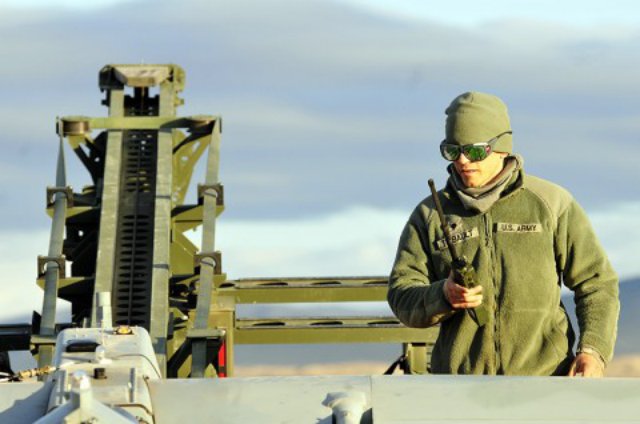
Spc. David Thibault, F Troop, 2nd Squadron, 17th Cavalry Regiment, 101st Combat Aviation Brigade conducts pre-flight operations at the National Training Center, Fort Irwin, CA - Photo: Sgt. Tracy Weeden
Task Force Saber, 2nd Squadron, 17th Cavalry Regiment, 101st Combat Aviation Brigade, made their debut to the National Training Center with F Troop and the RQ-7 Shadow UAS.
The 101st CAB is the first to have the UAS organic to their unit, truly creating a full spectrum aviation brigade.
One of the most advanced aspects of the Shadow is its ability to transmit live video feed to ground and aviation forces simultaneously, said Capt. Nathan Parker, F Troop commander. This technology also allows rotary wing assets, such as the CAB, to conduct covert operations by specifying a target prior to visual contact.
“It allows air mission commanders to have additional options for developing tactical operations,” he said. “Serving as an external observation device, it permits for manned and unmanned teams to work in areas that are a high threat to aviation.”
While the UAS is able to transmit live video, the ground force commander and the helicopter pilot can positively identify a target without risk to friendly troops. “Ground forces will benefit from the additional surveillance the UAS will provide,” said Parker.
The new troop is comprised of UAS operators and maintainers. One operator will designate the UAS flight path, while the other will control the camera. The operator is also responsible for communicating with pilots and ground force commanders in order to achieve their intent.
“I’m looking forward to deploying now, because I know that providing surveillance will help our ground troops stay safe,” said Spc. Jessica Palmer, F Troop, 2-17 CAV maintainer. “The time we are spending at NTC helps us come together as a team, and work out all the kinks before we deploy.”
Because this is new technology to a combat aviation brigade, the squadron is working diligently with army aviation headquarters to develop a long-term doctrine, said Parker.
Since the 101st CAB is the first aviation brigade fielding this technology, some veteran operators are adjusting too. “There is a lot of new equipment being with the first full spectrum CAB,” said Staff Sgt. Luther York, F Troop, 2-17 CAV UAS operator. “You also get to be a lot more involved in the mission with aviation.”
As an UAS operator you get to have radio communication with the ground and air elements while everyone is looking at the same video feed. Operators must be very vivid and descriptive with their target descriptions when handing it off to the aviators.
“After this, I have confidence we will have a much better idea of what we are doing in Afghanistan,” said York.
Prior to the UASs being fielded with CAB units, UAS were mostly used by military intelligence and infantry units. “It is completely different,” said Spc. David Kennedy, F Troop, 2-17 CAV UAS operator. “Working with the pilots has taught operators a lot of what this new job entails, such as communication techniques.”
Together, the pilots and operators of Task Force Saber are familiarizing themselves with the equipment and technology of their new tool at NTC to prepare for future operations.
Source: Clarksville Online
